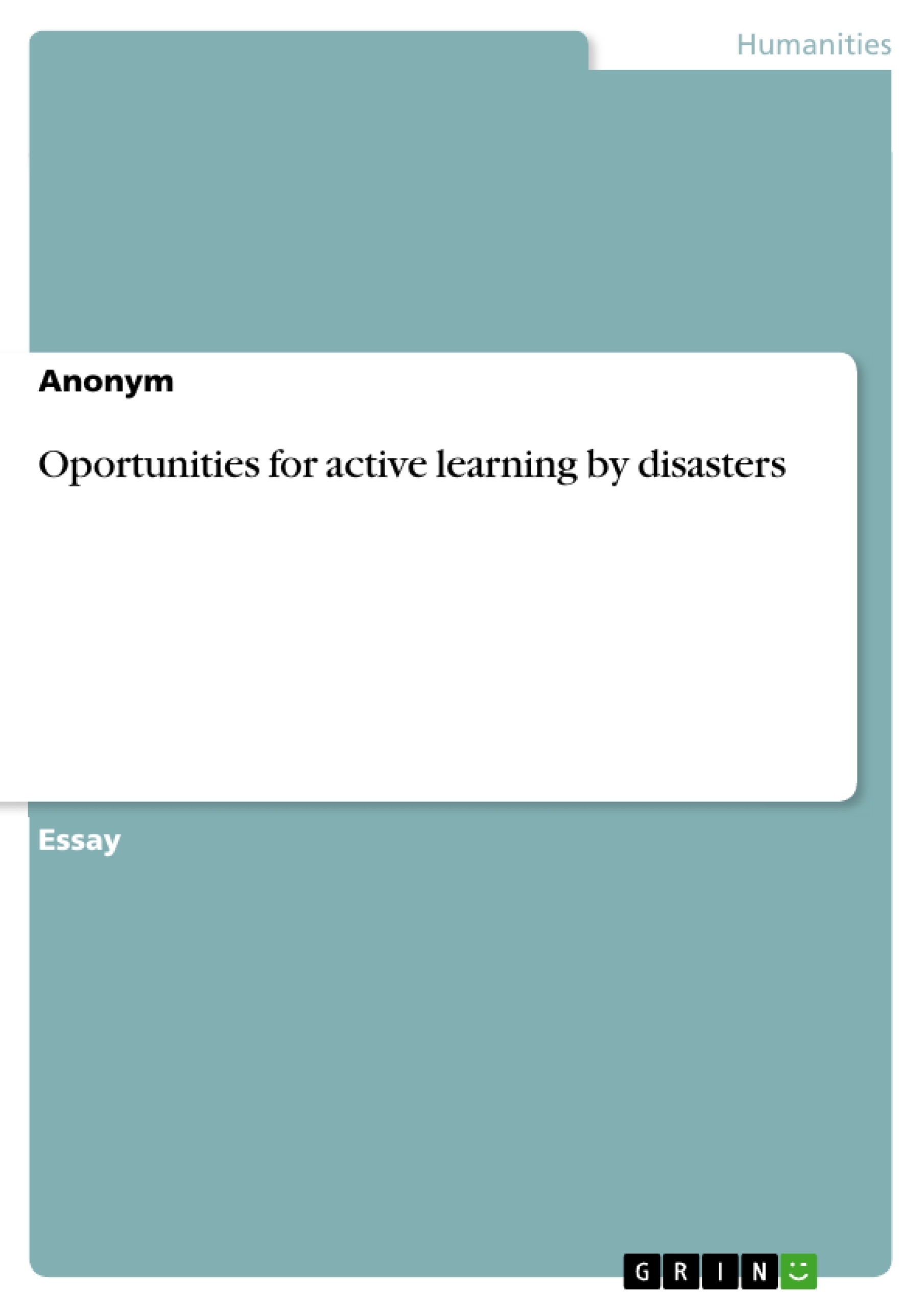Disasters have adversely affected humans since the dawn of their existence. If we look on the past as a model for what we might expect to see in the future, we find that severe events that wreaked havoc on human communities and inflicted high levels of mortality were surprisingly frequent and widespread. Disasters can be caused either by nature, e.g. earthquakes and tsunamis, or can be man-made, e.g. terror attacks and severe industrial accidents. The number of disasters increased threefold within the 1980’s in comparison with the 1960’s, the economic loss increased by a factor of almost nine during the same period, while the number of affected people rose from 147 million a year in the 1980’s to 211 million a year in the 1990’s. This rise in numbers and suffering may have been a contributing factor, why the United Nations designated the 1990’s as the International Decade for Natural Disaster Reduction. Toft and Reynolds reflect on the damages of re-occurring disasters by stating “We owe it [learning] to those who have lost their lives, been injured, or suffered loss to draw out the maximum amount of information from those lessons and to apply it to reduce future suffering.”
Inhaltsverzeichnis (Table of Contents)
- Introduction
- Theoretical Perspectives
- Definition of a Disaster
- Definition of Active Learning
- Definition of Disaster Management Cycle
- Mitigation
- Opportunities for active learning during the mitigation phase
- Preparedness
- Opportunities for active learning during the preparedness phase
- Response
- Opportunities for active learning during the response phase
- Recovery
- Opportunities for active learning during the recovery phase
- Examples
- The Hokkaido – Nansei – Oki tsunami, 12 July 1993
- Opportunities for active learning during the mitigation phase
- Opportunities for active learning during the preparedness phase
- Opportunities for active learning during the response phase
- The Hokkaido – Nansei – Oki tsunami, 12 July 1993
Zielsetzung und Themenschwerpunkte (Objectives and Key Themes)
This paper explores the potential of active learning in disaster management, focusing specifically on tsunami events in Japan. The aim is to understand how experiences from past disasters can be used to improve preparedness, response, and recovery efforts, ultimately leading to a reduction in the impact of future events.- Definition of Disaster, Active Learning, and Disaster Management Cycle
- Active Learning Opportunities Across the Disaster Management Cycle
- Analysis of Active Learning in the Context of Two Tsunami Events in Japan
- The Importance of Considering Sociocultural Aspects in Disaster Management
- The Role of Media and Public Perception in Disaster Preparedness
Zusammenfassung der Kapitel (Chapter Summaries)
The introduction sets the stage by highlighting the devastating impact of disasters and the need for learning from past events to mitigate future risks. The paper focuses on tsunami events in Japan to illustrate the role of active learning. The second chapter establishes a theoretical foundation by defining key concepts such as disaster, active learning, and the disaster management cycle. The definition of disaster adopted from the UN International Strategy for Disaster Risk Reduction emphasizes the disruption of functioning and the exceeding of coping capabilities. Active learning is defined as the use of experience to rectify deficiencies and generate foresight, particularly within disaster management. The disaster management cycle, consisting of mitigation, preparedness, response, and recovery, provides a framework for understanding the continuous process of disaster management. The third chapter focuses on the importance of mitigation, outlining methods to reduce hazard risks through regulatory measures, infrastructure adjustments, and public training. Active learning opportunities during mitigation involve considering sociocultural aspects alongside technical measures. Examples include HIV prevention programs that incorporate gender equality and the historical use of tsunami stones in Japan to raise public awareness. The fourth chapter addresses disaster preparedness, which involves proactive actions to ensure effective response and recovery. Opportunities for active learning in this phase highlight the importance of risk communication, considering sociocultural factors such as age, physical capacity, and perception. The media's role in shaping public perception is discussed, along with the need to address misconceptions that can arise from excessive media exposure. The fifth chapter examines the response phase, emphasizing the importance of coordinated actions to limit casualties and damage. Active learning in this phase focuses on managing information, overcoming perception barriers, and adapting to non-routine events. The example of NGO workers in Gujarat, India, illustrates how sociocultural factors can influence the effectiveness of response actions. The sixth chapter delves into the recovery phase, stressing the need for a systematic approach to restore communities and livelihoods. Active learning in recovery involves learning from immediate experiences and addressing deficiencies that contributed to the disaster. The example of Haiti highlights the challenges of coordinating aid and avoiding waste due to competition. The final chapter examines two specific tsunami events in Japan: the Hokkaido – Nansei – Oki tsunami of 1993 and the Tohoku tsunami of 2011. The chapter analyzes active learning opportunities across the disaster management cycle for each event, exploring how these experiences can inform future mitigation, preparedness, response, and recovery efforts.Schlüsselwörter (Keywords)
This paper primarily focuses on the concept of active learning in the context of disaster management. Key areas of exploration include disasters, especially tsunamis in Japan, the disaster management cycle, sociocultural factors, risk communication, media impact, and response coordination. Other important terms include mitigation, preparedness, recovery, and the integration of technical and social approaches to disaster management.- Quote paper
- Anonym (Author), 2013, Oportunities for active learning by disasters, Munich, GRIN Verlag, https://www.grin.com/document/271675



